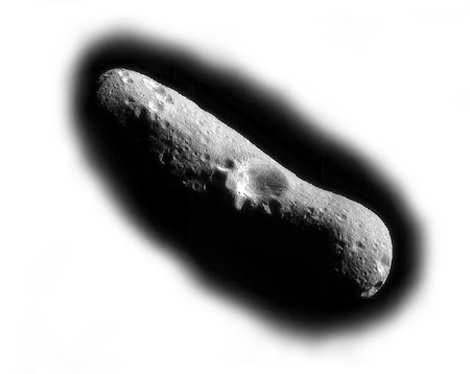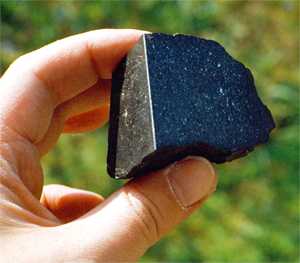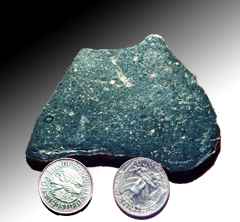|
| |

Eros N20000217a - Asteroids
are the mother bodies of the meteorites.
Here: Eros, photographed by the NEAR Shoemaker Space Probe.
Allende
 Chihuahua,
Mexico Chihuahua,
Mexico
Fell 1969, February 8, 0105 hrs
Tkw: ~3t
Carbonaceous chondrite CV3
(23.85%
total iron)
This renowned meteorite descended as a shower upon an area
of 10 x 50km2; some 3 t of material have been collected since.
Allende is the only carbonaceous chondrite available to collectors at an
accessible price. Much has been said and even more written on Allende. Allende
is often referred to as the Rosetta stone of planetology, for, having arisen
from the primal solar nebula, it provides us with most precious insight into the
composition of that nebula as well as the conditions under which our solar
system formed. A few research results:
The
protoplanetary nebula was not homogeneous in composition, density and
temperature. The krypton, xenon and nitrogen contents of Allende's micro-diamond
inclusions present isotope ratios unknown in our solar system. - Which means
that those diamonds are of interstellar origin.
Allende contains
an increased concentration of aluminium-26 decay products, which can only
originate from a supernova explosion in our sun's neighbourhood. The shock waves
of that explosion may have been the cause of the collapse of the primal solar
nebula. Allende contains the famous calcium-aluminium-rich inclusions (CAIs)
which are considered to be the very first concrete, and therefore the oldest,
matter in our solar system, (Cf. the especially large, whitish spot of irregular
shape at the bottom, on the right.) By know, the Allende strewnfield is
exhausted, having caused prices to rise in recent years (current average price 7.70$/g).
5.50$/g.
Endcut with large
cut surface and some fusion crust
ca.
6.5cm x 4.5cm x 2.5cm
77g
$423.50
Dar
al Gani 232
 Sahara,
Libya Sahara,
Libya
Found 1997
Olivine-hypersthene chondrite, unequilibrated
L3
Over the last ten years, systematic searches have been
performed in those regions of the Sahara desert which, due to their surface
nature, lend themselves to such exploration. Hundreds of new meteorites were
discovered which found their way into trade under such names as Sahara, Dar al
Gani, Açfer, Hammada al Hamra, Bechar, Tagounite + find number. Those desert
meteorites are the cheapest of all, and represent an excellent occasion for the
collector to acquire somewhat rarer classes, too, such as the L3 and H3 types.
The "Catalogue of Meteorites" (1985) lists only 13 pure, non-antarctic
L3s, out of a total of 669 representatives of the L-group. For the H3s, the
ratio is 15:681. That's why those unequilibrated chondrites are so high in
demand and expensive (for more on that cf. DaG 316): In Nov 99 the non-desert
L3s cost 40$/g on average, the desert finds 27$/g. (H3s are considerably
cheaper) 9.50$/g.
Cut
fragment ca. 4cm x 2cm x
1.5cm
22.13g
$210
Dar
al Gani 316
 Sahara,
Libya
Found 1997, July Sahara,
Libya
Found 1997, July
Tkw: 4236g
Olivine-bronzite chondrite, unequilibrated H3
For
desert finds, cf. DaG 232. Most probably, all chondrites were at one stage
chondrites of the petrological type 3. In type-3 chondrites the globular
silicate inclusions, the so called chondrules, distinguish themselves clearly
from the fine-crystalline ground mass (matrix). Those rock masses were probably
situated at only a moderate depth inside their body of origin. The smaller
asteroids were never heated up to an extent that would have caused them to melt,
but the temperatures towards the core incited further crystallisation and
crystal growth in the chondritic material, so that the chondrules in type 4 to
type 6 present more and more close linkage with the matrix, and that,
eventually, in type 6, there are only a few distinctly shaped chondrules left.
Furthermore, the type-3 meteorites are unequilibrated, i.e. the minerals of
equal chemical composition are present in a conglomerate of different crystal
types and their distribution is uneven. In types 4 to 6 those release ions, due
to heating, and dissolve. In brief: The type-3 meteorites are those ordinary
chondrites which are preserved in the most pristine of conditions. DaG 316 shows
shock stage S2 and weathering grade W3. 6.50$/g.
Fullslice
ca. 7.5cm x 6.5cm x 0.5cm
64.8g
$421.20
Densmore
(1879)
 Norton
County, Kansas, USA Norton
County, Kansas, USA
Found 1879
Tkw:
~55kg
Olivine-hypersthene chondrit L6
Three
fragments, totalling 37.2kg, were found by F.M.Kendrick 5km to the East and
2.4km to the South of Densmore; but it wasn't until 1939 that they were
recognized as meteoritic. A fourth piece of 15.4kg was discovered about 1950.
Densmore (1879), like most historical finds, is almost unavailable on the market
now (I for my part know of a single source only, where it is offered at 4$/g),
about 90% being held in state collections, 42kg of that in Washington, U.S. Nat.
mus. Densmore has a very beautiful, fresh, dark matrix with tiny little light
metal flakes. 3.50$/g.
Partslice,
one side polished
ca. 3.9cm x 3.4cm x 0.6cm
24.96g $87.40
El Hammami
 Tiris
Zemmour, Mauritania Tiris
Zemmour, Mauritania
Found 1997, Fell August 10?
Tkw: 240kg
Olivine-bronzite chondrite H5
Origin
and fall of this recent meteorite were for some time shrouded in darkness. In
early 1997 nomads sold a fragment in Morocco. They claimed to have found it in
Western Algeria after observing a bolide in January 1995. This material became
known under the name Hamada du Draa, or, less frequently, Mhamid, after the
place where it was sold. Those self-same nomads sold another piece in September,
which had allegedly fallen a month before. Upon which, in November, Edwin
Thompson found six unweathered stones in Mauretania, most probably at the site
of the fall, which were subsequently offered, in parallel to Hamada du Draa,
under the denomination El Hammami. By now (Meteoritical Bulletin No.82, 1998)
the two are considered to be one and the same. The data, for comparison:
Hamada
du Draa: olivine, Fa19.2; pyroxene Fs17.4; shock stage S2; type H5/6
El
Hammami :
Fa18.8;
Fs16.7;
S2;
H5
A
further striking feature of both meteorites is that they present metal-rich
veining. El Hammami is a truly ubiquitous meteorite, usually available at
1-2$/g. African meteorites, such as Gao or fabulous Zag, not to mention the
desert finds, are in general a whole lot cheaper than meteorites of other
continents, even though they are in no way inferior to these. Which makes them
particularly suitable for the beginning collector. This fragment here (still
purchased as Hamada du Draa) has four sides, the largest of them with crust. It
is of minor quality, for it shows strong oxidation traces. (In exchange, it
costs less than 1$/g). 0.80$/g.
Fragment
with crust ca. 8.3cm x
7.2cm x 6cm
288g
$230.40
Faith
 Perkins
County, South Dakota, USA Perkins
County, South Dakota, USA
Found 1952
Tkw: 105kg
Olivine-bronzite chondrite H5
A
single, large stone of 105kg was found 37km north-northeast of Faith, and in
1967 was officially recognised as a meteorite. These days, Faith is rarely
offered for sale. Small block with dark-brown matrix and clearly recognisable
chondrules. 3.75$/g.
Partslice
ca. 2.2cm x 1.7cm x 0.8cm 9.1g
$34.10 Sold
Forrest
(b)
 Western
Australia, Australia Western
Australia, Australia
Found 1980, October
Tkw: 26kg
Olivine-hypersthene chondrite L6
A
number of fragments was found 32km to the Southwest of Forrest. Brownish matrix,
fresh metal. 2$/g.
Cut
fragment ca. 6.3cm x 4cm x
1.3cm 36g $72
Gao
(Upper Volta)
 Burkina
Faso Burkina
Faso
Fell 1960, March 5, 1700 hrs
Tkw: >100kg
Olivine-bronzite chondrite H5
This
meteorite came down 60km to the North of Leo, on the border with Ghana, over a
strip of some 10km length, with some stones pertruding the roofs of a number of
huts, but fortunately none of the inhabitants were hit. There is some
uncertainty as to the total weight of the fall, with indications ranging from
100kg to 500kg. Gao, like most African meteorites, is very cheap; it stems from
a witnessed fall and is offered everywhere. The material known as Guenie or
Gao-Guenie belongs to the same fall. 1.75$/g.
Partslice
ca. 10.9cm x 3.7cm x 0.5cm
62g $108.50
Juangcheng
 Shandong,
China Shandong,
China
Fell 1997, February 15, 2323 hrs
Tkw: unknown, >70kg
Olivine-bronzite chondrite H5
After
the apparition of a glaring ball of fire which shed red light on the whole area
and was accompanied by crackling like of fireworks, hundreds of stones rained
down. (One is actually said to have plopped into a soup pot.) A few months
later, Deng Xiaoping died, so that, in retrospect, the fall of this meteorite
was interpreted as a foreboding of his death. This specimen shows a beautiful
fresh black melt crust an has been cut at the spot where it was damaged on
impact, which,  by
chance, brought to light a particularly large metal grain. Which means that with
this stone you needn't break the egg to make the omelette, but rather you can
both eat your cake and have it: indulge in looking at the almost completely
fresh crust and satisfy your curiosity with a look inside. Pretty specimen,
offered at a price significantly below the average of 5.10$/g (out of 15
vendors): 3.50$/g. by
chance, brought to light a particularly large metal grain. Which means that with
this stone you needn't break the egg to make the omelette, but rather you can
both eat your cake and have it: indulge in looking at the almost completely
fresh crust and satisfy your curiosity with a look inside. Pretty specimen,
offered at a price significantly below the average of 5.10$/g (out of 15
vendors): 3.50$/g.
Cut
individual with fresh crust.
6cm x 3.7cm x 3cm
116g
$406
Kainsaz
 Muslyumov,
Tatar Republic, Russia Muslyumov,
Tatar Republic, Russia
Fell 1937, September 13, 1415 hrs
Tkw:
~200kg
Carbonaceous chondrite CO3
(25.56% total iron)
This
was a witnessed fall of 15 stones, the largest of which weighed 102.5kg. CO3
meteorites differ from the CV3 types in as much as their chondrules are far
smaller. With its total known weight of 200kg, Kainsaz is the mightiest among
the CO3 meteorites. From this pristine meteorite, I can offer a part slice of
some size. Its hue is a blackish grey with many coloured and a few white
inclusions. Kainsaz is usually offered at 70-75$/g. My price is 45$/g. In  this
price range, the only thing you can usually get are CO3 desert finds. This
material, however, comes fresh from a fall. (At present, my offer is the
cheapest on the market - see for yourself.) 45$/g. this
price range, the only thing you can usually get are CO3 desert finds. This
material, however, comes fresh from a fall. (At present, my offer is the
cheapest on the market - see for yourself.) 45$/g.
Partslice
ca. 10.5cm x 4.8cm x 0.7cm 86.3g
$3883.50
Kunya-Urgench
 Saparmurat
Turkmenbashi, Tashauz, Dashkhowus Velayat, Turkmenistan Saparmurat
Turkmenbashi, Tashauz, Dashkhowus Velayat, Turkmenistan
Fell 1998, June 20, 1725 hrs
Tkw: ~1t
Olivine-hypersthene
chondrite L4 or
Olivine-bronzite chondrite H5
As
one can tell from the varying place names and types under which this meteorite
has shown up and which I have reproduced here, nothing definitive seems to be
known about this quite mighty fall, yet. I read that the main mass left behind a
6x4m² hole and that almost all the material was seized by the local
authorities. Until half a year ago, Kunya-Urgench was offered rather frequently
- today, however, it has disappeared from the market almost completely! And I,
too, have only this one piece left. 3.50$/g.
Fragment
ca. 4.8cm x 3.2cm x 1.5cm
40g
$140
Marlow
 Stephens
County, Oklahoma, USA Stephens
County, Oklahoma, USA
Found 1936, February
Tkw: 100kg
Olivine-hypersthene chondrite L5
In
1936, a weathered stone of just a few hundred grams was found, whereas the main
mass of 100kg wasn't discovered until 1987. Polished cut surfaces with a fresh,
elegant black matrix. 2$/g.
Cut
fragment, polished
ca. 5cm x 4.5cm x 3cm
118.8g
$237.60 Sold

Murchison
 Victoria,
Australia Victoria,
Australia
Fell 1969, September 28, 1045-1100 hrs
Tkw: 100kg
Carbonaceous chondrite CM2
(22.13% total iron)
There
are some 12kg of Murchison available to private collectors. The CM2 types,
together with the C1 types, represent the most primitive and pristine matter in
our solar system. Murchison also has CAIs (cf. Allende). A very interesting
feature about it is its water content (12%) and, first and foremost, the fact
that Murchison contains over 100 amino acids, the basic components of biological
life. This gave new vitality to the old theory of "lithospanspermism",
according to which life was inoculated into the primeval earth (life on earth,
however, uses only laevorotatory amino acids whereas Murchison contains neither
laevo- nor dextrorotatory ones) and on the occasion of the 1997 San Diego Optics
Conference, even the discovery of "fungoid and other possibly biological
fossile structures" under the ESEM microscope was claimed. Furthermore,
there is some reason to believe that CM2 meteorites stem from comet cores. So
let's remember the last two marvellous comets, Hyakutake and Hale-Bopp: Now here
you can touch one of these! Very fresh fragment with crust; however, there is a
colour mark on the crust. 65$/g.
Fragment
with fusion crust ca. 2.5cm x 2.1cm x 0.9cm
7.0g
$455
Pultusk
 Warsaw,
Poland Warsaw,
Poland
Fell 1868, January 30, 1900 hrs
Tkw: >>200kg
Olivine-bronzite chondrite, veined, brecciated
H5
(27.24% total iron)
The
tremendous shower of Pultusk is the most famous meteorite fall of the 19th
century. On the evening of Jan 30th 1868, between Pultusk and Ostrolenka on the
Narew, no fewer than 180 000 stones rained down on an area of 1.5 x 8km2; only
some 200 of these weighed more than 1kg. The trajectory of the fireball, which
entered at an angle of 44°, could be traced over a distance of 182km. The total
mass of the fall has been estimated at far beyond 2t, nevertheless only slightly
under 250kg have been preserved in the collections of this world of ou rs!
Pultusk is offered on the market more and more rarely, at largely varying
prices. For the collector of historic falls, Pultusk is a must. This individual
is larger than the well-known "Pultusk peas" and has preserved an
almost complete fusion crust, whose fresh dull black hue reveals that this piece
must have been collected right after the fall. 20$/g. rs!
Pultusk is offered on the market more and more rarely, at largely varying
prices. For the collector of historic falls, Pultusk is a must. This individual
is larger than the well-known "Pultusk peas" and has preserved an
almost complete fusion crust, whose fresh dull black hue reveals that this piece
must have been collected right after the fall. 20$/g.
Individual,
almost fully crusted
ca.
2.2cm x 1.5cm x 1.7cm
10.33g
$206.60
St.
Lawrence
 Glasscock
County, Texas, USA Glasscock
County, Texas, USA
Found 1965
Tkw: 2.6kg
Olivine-hypersthene chondrite, amphoterite
LL6
Amphoterites
are ordinary chondrites, which differ from the L and H classes in as much as
they present a lower iron content of only 18.5-21.5%, only 0.5-4% of which is
still present in the form of metallic iron (LL = Low iron, Low metal).
This
one here is an ashlar (not unlike the ones that swirl around Jupiter in the
Odyssey movies), with one side polished. The high price is justified due to the
somewhat rarer class, but mainly due to the low total known weight of the find.
I don't thing much about people going about shouting "Last chance to
buy!", but if this item fits into your collection area or if, quite simply,
you fancy owning a meteorite hardly anybody else has, you should have an eye on
this one. 11$/g.
Polished
Partslice ca. 3.1cm x 2.2cm x
1cm
22.08g
$242.90
Saratov
 Near
Donguz, Penza, Russia Near
Donguz, Penza, Russia
Fell 1918, September 5, 1500 hrs
Tkw: 328kg
Olivine-hypersthene chondrite L5
Saratov
is a famous and well-documented meteorite from a spectacular fall (with
fireball, explosions and the whole paraphernalia… - the largest piece weighed
160kg). Saratov material is known for its exceptionally large chondrules - some
inclusions measure almost one cm in diameter! Saratov is of very loose and
crumbly consistency, so that it can hardly be sawed into stable thin slices. The
slice offered here shows the typical rust halos that inevitably form around the
chondrules within a short time after cutting. Despite its peculiarities, Saratov
can be offered considerably cheaper than American L4s. 1.70$/g.
Partslice
ca.10.5cm x 7.5cm x 1.4cm
276g
$469.20 Sold
Tsarev
 Volgograd,
Russia Volgograd,
Russia
Found 1968, Fell 1922, December 6, 1500 hrs?
Tkw: 1225kg
Olivine-hypersthene chondrite L5
(20.54% total iron)
Even
though the fall of Tsarev on December 6th 1922 was probably witnessed, the
meteorite wasn't discovered until 1968, and it took another 11 years for the
discovered masses to be recognised as meteoritic. All in all 44 chunks, the
largest of which weighed 284kg, were discovered, the total weight being 1225kg.
This
makes Tsarev the third largest stone meteorite after Allende and Jilin (there
isn't much left of Pultusk, and the Tkw of Kunya-Urgench has yet to be
determined), so that it should be present in every collection. However, there
isn't much of Tsarev on the market. Tsarev is heavily shocked material with a
black matrix. 2.50$/g.
Fullslice,
polished ca. 8.3cm x 5.7cm x
0.6cm
78g $195
Sold
|
![]()